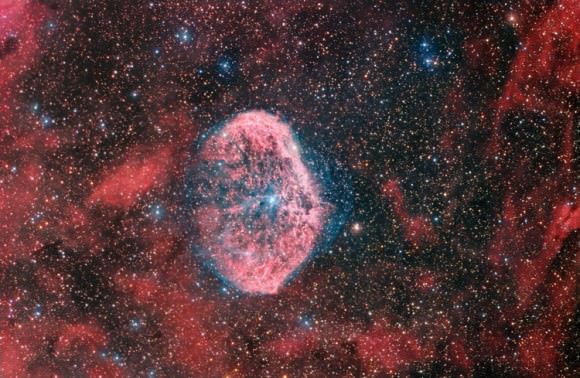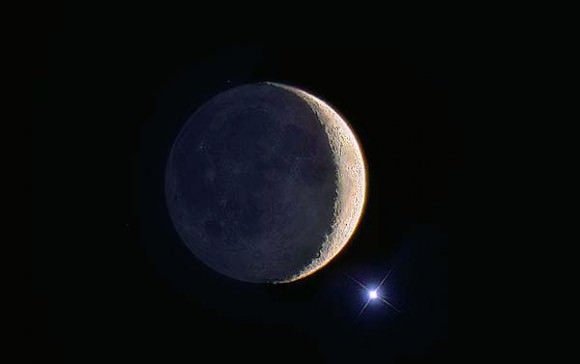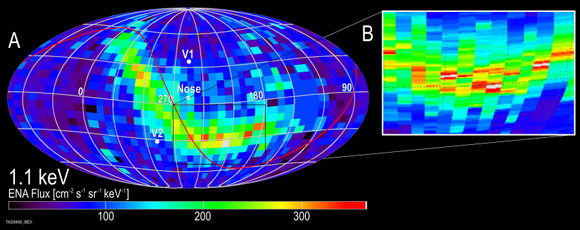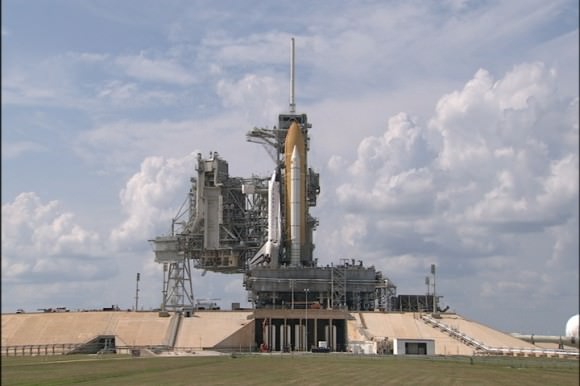Where Could Humans Survive in our Solar System?
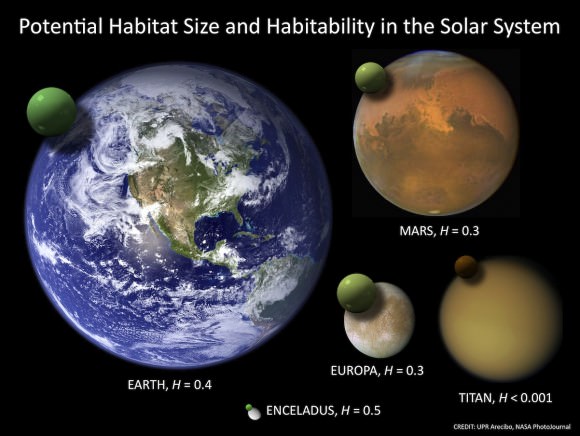
If humans were forced to vacate Earth, where is the next best place in our solar system for us to live? A study by the University of Puerto Rico at Arecibo has provided a quantitative evaluation of habitability to identify the potential habitats in our solar system. Professor Abel Mendez, who produced the study also looked at how the habitability of Earth has changed in the past, finding that some periods were even better than today.
(...)
Read the rest of Where Could Humans Survive in our Solar System? (666 words)
Hot Crescent Rolls… A Bubble?
The Crescent Nebula, also known as NGC 6888, is a very well renown and most intriguing object located in the constellation Cygnus in the northern hemisphere. At an apparent size of about 18 by 13 arc-minutes it is a very pale nebula. Even in a moderate amateur telescope you can't quite see this one unless you have absolute dark skies (or narrow band filters) and a decent "light bucket". So how do we get a chance to study it? Photographically, of course… (...)
Weekend SkyWatcher's Forecast – October 16-18, 2009
Greetings, fellow Stargazers! Were you up early this morning? If so, you were greeted by an awesome scene, much like this one captured by Danilo Pivato. There's nothing more eyecatching the a close appearance of Venus and the Moon! With dark skies this weekend, it will be a good opportunity to broaden your astronomical horizons by chasing lesser known objects in both binoculars and telescopes. Of course there are challenges, too! Whenever you're ready, I'll see you in the back yard…. (...)
Read the rest of Weekend SkyWatcher's Forecast – October 16-18, 2009 (774 words)
Spacecraft Detects Mysterious "Ribbon" at Edge of Solar System
Since it launched a year ago, the Interstellar Boundary Explorer (IBEX) has been monitoring heliosphere and how our Sun interacts with and the local interstellar medium — the gas and dust trapped in the vacuum of space. The first results from the mission, combined with data from the Cassini mission, are showing the heliosphere to be different from what researchers have previously thought. Data show an unexpected bright band or ribbon of surprisingly high-energy emissions. "We knew there would be energetic neutral atoms coming in from the very edge of the heliosphere, and our theories said there would be small variations in their emissions," said David McComas, IBEX Principal Investigator at a press conference on Thursday. "But instead we are seeing two-to-three hundred percent variations, and this is not entirely understood. Whatever we thought about this before is definitely not right."
(...)
Read the rest of Spacecraft Detects Mysterious "Ribbon" at Edge of Solar System (573 words)
If We Live in a Multiverse, How Many Are There?
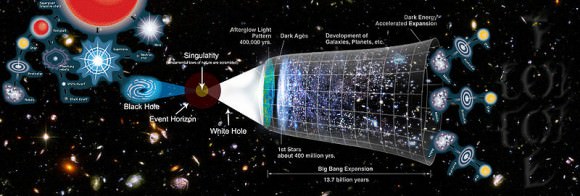
Theoretical physics has brought us the notion that our single universe is not necessarily the only game in town. Satellite data from WMAP, along with string theory and its 11- dimensional hyperspace idea has produced the concept of the multiverse, where the Big Bang could have produced many different universes instead of a single uniform universe. The idea has gained popularity recently, so it was only a matter of time until someone asked the question of how many multiverses could possibly exist. The number, according to two physicists, could be "humongous."
(...)
Read the rest of If We Live in a Multiverse, How Many Are There? (537 words)
NASA Science News for October 15, 2009
NASA's IBEX spacecraft has discovered a vast, glowing ribbon at the edge of the solar system. One mission scientist calls the discovery "shocking" and says theorists are "working like crazy" to explain the finding.
FULL STORY at
http://science.nasa.gov/headlines/y2009/15oct_ibex.htm?list1035898
NASA Science News for October 15, 2009
How do you fly on a world with no atmosphere? Wings won't work and neither do propellers. The space agency is perfecting the art of "airless flying" using a prototype lunar lander at the Marshall Space Flight Center.
FULL STORY at
http://science.nasa.gov/headlines/y2009/15oct_lunarlander.htm?list1035898
Tweet Your Way to the Next Space Shuttle Launch
Space shuttle Atlantis rolled out to Launch Pad 39A on Wednesday in preparation for the next shuttle flight, STS-129, currently scheduled for liftoff on Nov. 12, 2009 at 4:04 p.m. EST. And in case you haven't heard, for the first time, NASA is inviting those who use Twitter to view a space shuttle launch in person. The first 100 people who sign up on NASA's website will be granted access to Kennedy Space Center on Nov. 11 and 12 for the opportunity to take a tour of the facilities, view the space shuttle launch and speak with shuttle technicians, engineers, astronauts and managers. The Tweetup will include a "meet and greet" session to allow participants to mingle with fellow Tweeps and the staff behind the tweets on @NASA. An additional 50 registrants will be added to a waitlist. Registration opens at noon EDT on Friday, Oct. 16. To sign up and for more information click here.
(...)
Read the rest of Tweet Your Way to the Next Space Shuttle Launch (165 words)
Asteroid Pallas is Also a Protoplanet
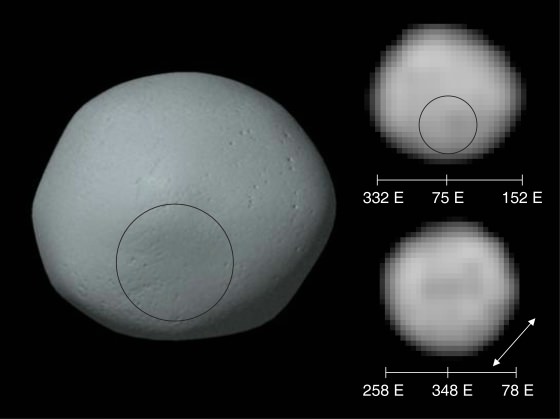
Some objects in the solar system are in a "gray area," and can be classified under more than one heading. Add the asteroid Pallas to that group. New close-up images of Pallas from the Hubble Space Telescope reveal that the second largest asteroid in the solar system appears to be a protoplanet, as well.
(...)
Read the rest of Asteroid Pallas is Also a Protoplanet (492 words)
A Very Large 3-D Movie
Quick! Grab a pair of red and green 3-D glasses and slap them on to watch this great time lapse video of the Very Large Telescope at the Paranal Observatory, high in the Atacama Desert in Chile. It shows a complete night at the observatory, and you can see the four 8m telescopes and the four 1.8m telescopes of the VLT working, all in 3-D. The video comes from the handiwork of astrophotographer and head Optics Engineer on the VLT, Stéphane Guisard. If that name sounds familiar, Stéphane has recently been working with ESO and fellow astrophotographer Serge Brunier on the GigaGalaxy Zoom project. Click this link to go directly to GigaGalaxy Zoom, or read one of our previous articles about them here. It was made by using two cameras taking pictures simultaneously, which were combined to create an anaglyph time lapse movie. Two notes about the movie: the telescopes and domes were lit by the moonlight, and the International Space Station crosses the sky during the very first seconds of the movie.
(...)
Read the rest of A Very Large 3-D Movie (10 words)
Amazing Zoomable Poster on 50 Years of Space Exploration
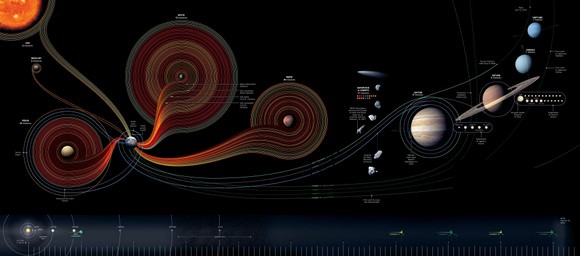
National Geographic has put together a really nice zoomable poster on the history of robotic space exploration. It looks a little psychedelic from a distance, but zoom right in and follow the different missions to the various locations in our solar system, and see where the missions currently underway — like New Horizons, on its way to Pluto, and the venerable Voyagers that we hear from occasionally– are presently located. Click on the image to go to National Geographic's Map of the Day page. Enjoy!
Hubble's Amazing Rescue on NOVA
In a world where you have just one chance to save a dying explorer, the only hope is a space shuttle mission …(said in my deepest, most dramatic voice….) Enjoy this movie-like trailer for the upcoming NOVA special on PBS stations in the US, "Hubble's Amazing Rescue." It looks like a great show, providing the chance to re-live the exciting 12-day Hubble Servicing Mission 4 and its five pressure-filled spacewalks. Hubble's Amazing Rescue premieres Tuesday, October 16th at 8PM ET/PT on PBS. Find out more about the show and check local listings for your area here.
Moon Impact Data and Images from LCROSS: First Glance
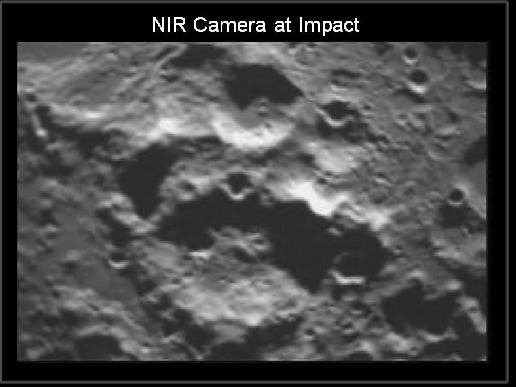
Even without big explosions or bright plumes of ejecta, for all intents and purposes it appears LCROSS's impact on the Moon was a smashing success. While the mainstream media and the public seemed disappointed in the lack of visual data, mission managers said the mission has garnered plenty of spectroscopic data, and that's where the real science can be found. "There was an impact and we saw the crater with spectroscopic data," said LCROSS principal investigator Tony Colaprete. "We have the data we need to address the questions we set out to answer." The big question is whether the impact kicked up any signatures of water ice, but it could take days, weeks or months to analyze all the data.
(...)
Read the rest of Moon Impact Data and Images from LCROSS: First Glance (988 words)
No, NASA Is Not Bombing the Moon
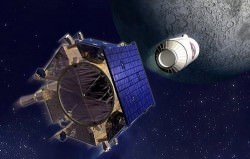
There seems to be a little lunacy making the rounds that NASA is going to "bomb" the Moon on Friday morning, or "hurt the Moon," or "split the Moon in half," or change its orbit. This is all just nonsense and scare-mongering, and those worried about our Moon can rest assured our lunar companion will remain in the sky relatively unchanged after this experiment to search for water ice on the Moon's south pole. Let's take a look at the physics involved and what might happen to the Moon.
(...)
Read the rest of No, NASA Is Not Bombing the Moon (762 words)
This Week's Where In The Universe Challenge
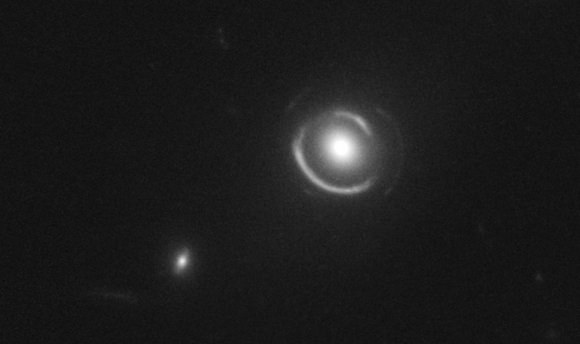
I'm a day late (sorry!) but here's this week's image for the Where In The Universe Challenge, to test your visual knowledge of the cosmos. You know what to do: take a look at this image and see if you can determine where in the universe this image is from; give yourself extra points if you can name the spacecraft responsible for the image. We’ll provide the image today, but won’t reveal the answer until tomorrow. This gives you a chance to mull over the image and provide your answer/guess in the comment section. Please, no links or extensive explanations of what you think this is — give everyone the chance to guess.
